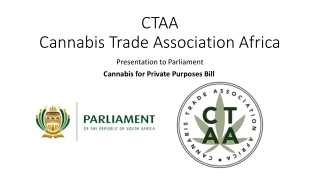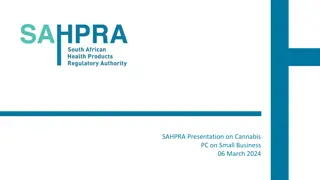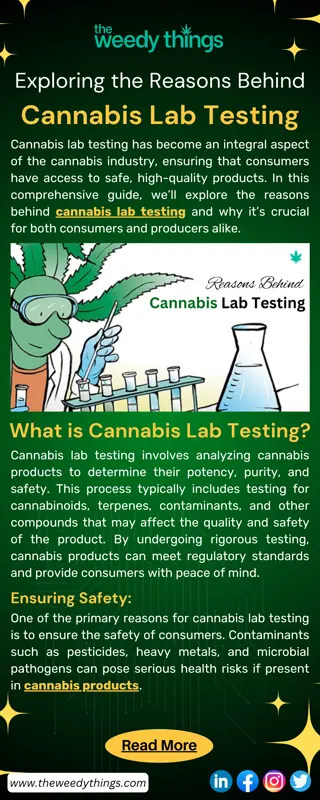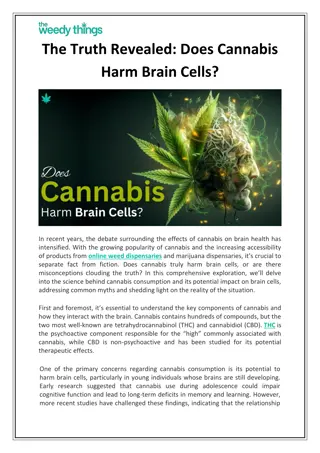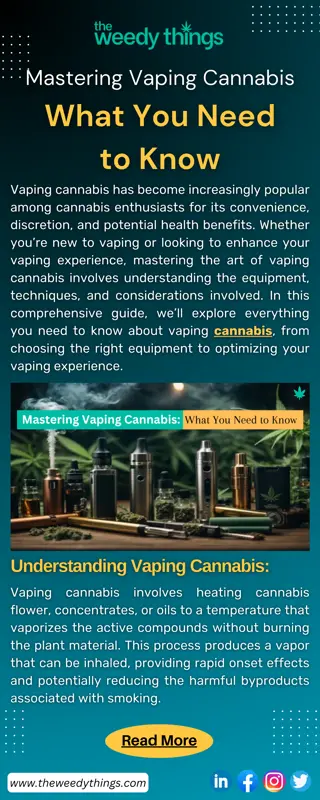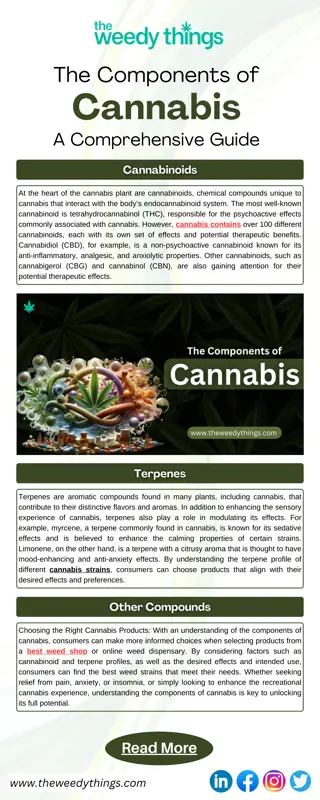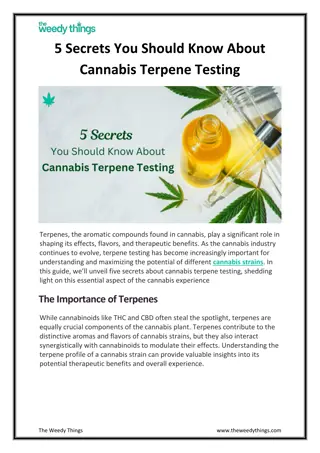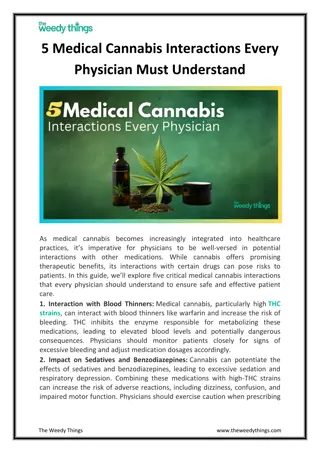Ohio Non-Medical Cannabis Program Overview
Metrics, licenses issued, projected dispensaries, and key provisions of Ohio's non-medical cannabis program are outlined in detail. The program covers possession limits, regulatory framework, tax structure, cultivation area expansion, and background checks.
Download Presentation

Please find below an Image/Link to download the presentation.
The content on the website is provided AS IS for your information and personal use only. It may not be sold, licensed, or shared on other websites without obtaining consent from the author.If you encounter any issues during the download, it is possible that the publisher has removed the file from their server.
You are allowed to download the files provided on this website for personal or commercial use, subject to the condition that they are used lawfully. All files are the property of their respective owners.
The content on the website is provided AS IS for your information and personal use only. It may not be sold, licensed, or shared on other websites without obtaining consent from the author.
E N D
Presentation Transcript
MEDICAL PROGRAM BY THE NUMBERS Metric Number Licensees Cultivators 37 Processors 46 Testing Labs 7 Dispensaries 141 Total 231 Patients/Caregivers/Physicians Registered Patients (Historical) 436,009 Active Patients (Purchasing) 162,059 Caregivers 40,292 Physicians (Certificates to Recommend) 589 2
INITIATED STATUTE NON-MEDICAL LICENSES Level I cultivator: issued three non-medical dispensary licenses and one non-medical cultivator license at the current facility location. Level II cultivator: issued one non-medical dispensary license and one non-medical cultivator license at current facility location. Processor: one non-medical processor license at current facility location. Testing Lab: one non-medical lab at current facility location. Dispensary: issued a non-medical license for the current location and one additional dispensary if the dispensary does not have common ownership or control of a cultivator or processor. Social Equity: requires the Division to issue forty Level III non-medical cultivator licenses and fifty non-medical dispensary licenses with a preference to applications who are participants under the cannabis social equity and jobs program. The Department of Development shall establish the cannabis social equity and jobs program, adopt rules, and certify applicants. *Division has authority (after 24 months) to issue more adult-use licenses to meet demand. 3
INITIATED STATUTE NON-MEDICAL LICENSE TIMELINE Date Statutory Requirement December 7, 2023 Statute became effective 30 days after approval. June 7, 2024 (six months) Deadline to issue non-medical license applications. September 7, 2024 (nine months) Deadline to issue non-medical licenses. 4
PROJECTED DISPENSARIES Dispensaries Number Dual-Use (Medical/Non-Medical) 141 10(B) Dispensaries +168 Total Non-Medical Dispensaries (Current Operators) 309 Non-Medical Social Equity Dispensaries +50 Total Non-Medical (Including Social Equity) 359 5
INITIATED STATUTE KEY PROVISIONS Possession and Home Grow: Allow Ohioans aged 21 years or older to buy and possess 2.5 ounces of cannabis and 15 grams of concentrates and grow up to 6 plants in secure places at home (12 plant cap per household). Regulatory: Department of Commerce (Division of Cannabis Control) to regulate and license non-medical cannabis market, including administrative investigatory and enforcement authorities. Excise Tax and Program Funds: Imposes a 10% tax (on top of sales tax) with tax revenue divided among the following: o Cannabis social equity and jobs fund (36%) o Host community cannabis facilities fund (36%) o State substance abuse and addiction fund (25%) o Division of Cannabis Control and Tax Commissioner fund (3%) Cultivation Area Expansion: o Allows Level I cultivators to expand to 100,000 sq/ft and Level II cultivators to expand to 15,000 sq/ft once an adult use license is issued. o Allows Level III adult use cultivator have up to 5,000 sq/ft of cultivation are and any additional expansion must be approved by the Division. Background Checks: requires criminal background checks of owners, operators, officers, board members, and licensed employees of cannabis operators and labs. 6
INITIATED STATUTE PROHIBITIONS AND INSTITUTION PROTECTIONS Consumption Prohibitions: o Prohibits use of cannabis by those individuals under 21 years of age. o Prohibits use while driving as well as smoking or vaporizing by vehicle passengers. o Public Consumption: o Does not require or prohibitany public place from accommodating an individual s use of adult use cannabis. o Cannabis consumption is subject to the Ohio smoking ban (including the prohibition on smoking or vaping in public indoor spaces) and bars/restaurants with liquor permits can t knowingly allow the use of controlled substances, which includes marijuana. o Non-medical cannabis consumer who uses non-medical cannabis in public areas is guilty of a minor misdemeanor. Location Prohibitions: o Allows cities, villages, and townships to prohibit or limit non-medical operators. o No cannabis operator shall be within five hundred feet of a prohibited facility, which includes a school, church, public library, public playground, or public park. School means a public or nonpublic primary or secondary school, childcare center, and preschool. o Permits landlords to prohibit home grow and smoking of cannabis if the prohibition is included in lease agreement. Rights of the Employer: o Maintains Rights of Employer provisions to allow employers to refuse to hire or otherwise take an adverse employment action due to the individual s use, possession, or distribution of cannabis. Academic Research: o Does not restrict research related to cannabis at a state university, academic medical center, or private research and development organization as part of a research protocol approved by an institutional review board or equivalent entity. 7
INITIATED STATUTE CANNABIS ADDICTION SERVICES Cannabis Addiction Services Program: Division of Cannabis Control and Department of Mental Health and Addiction Services agreement under which the Department will establish a program for cannabis addiction services which includes best practices for education and treatment for individuals with addiction issues related to cannabis or other controlled substances including opioids. Substance Abuse and Addiction Fund: The Director of Mental Health and Addiction services to administer the substance abuse and addiction fund to support addiction services or other services that relate to addiction and substance abuse, and research that relates to addiction and substance abuse. Toll-Free Telephone Number: The Department of Mental Health and Addiction services shall establish, operate, and publicize an in-state, toll-free telephone number Ohio residents may call (24 hours/7days) to obtain basic information about addiction services available to consumer, and options for an addicted consumer to obtain help. Informational Resources: License holders required to provide informational resources for patrons related to cannabis addiction issues and services. Employee Training: License holders required to provide training for their employees regarding the cannabis addiction services resources for patrons related to this section. 8
PRODUCT SAFETY The Division s top priority is product safety, which is supported by cannabis production, retail, and testing laboratory compliance, accountability, and quality assurance. Product Testing All plant material is tested at independent certified labs to determine potency and to detect contaminants that may be harmful to patients. Plant material that is processed in the permitted forms are subject to additional testing to determine potency and ensure the end product is safe for use. Licensed testing labs are required to obtain ISO/IEC 17025 accreditation and must also employ a qualified scientific director to ensure that the lab achieves and maintains quality standards of practice. Product Packaging Products must be sold in child-resistant packaging that is clearly labeled as containing THC. Products also must be labeled with important information, such as the amount of THC contained in the package and any ingredients used in edible products. Beginning October 14, all products delivered to a dispensary for sale to customers must contain the DCC seal. Public Awareness If a product is identified as noncompliant with the program, the Division works to inform patients, consumers, and licensees of the issue immediately. 9
DIVISION STAKEHOLDER ENGAGEMENT Trade Associations Program Site (Data) Public Education Campaigns Financial Institutions Industry and Public Public Safety (DPS) and local law enforcement Health and Mental Health Development (Cannabis Social Equity and Jobs Program) Interagency Direct Engagement Cannabis Regulators Association (CANNRA) State Regulators 10
DIVISION OF CANNABIS CONTROL RESOURCES Division of Cannabis Control site: www.com.ohio.gov/cannabiscontrol Non-Medical Cannabis FAQ: www.com.ohio.gov/nonmedicalcannabis Program Update (Monthly): https://com.ohio.gov/divisions-and- programs/cannabis-control/licensee-resources/what-we-do/mmcp- program-update Sign Up to Receive Division Updates: https://public.govdelivery.com/accounts/OHDOC/subscriber/new 11


